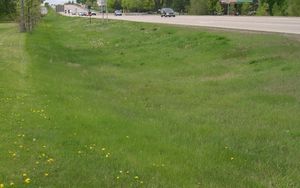
Overview for dry swale (grass swale)
This site is in development
Dry swales, sometimes called grass swales, are similar to bioretention cells but are configured as shallow, linear channels. Dry swales function primarily as a conveyance BMP, but provide treatment of stormwater runoff, particularly when used in tandem with check dams that temporarily retain water in a series of cells. Dry swales are designed to prevent standing water. The filter bed consists of a sandy loam subsoil or engineered soil media mix, which allows the water to filter through and remove some pollutants. Dry swale design may also include an underdrain that carries away water in the drain pipe after it has filtered through the base media. Dry swales may thus be constructed as filtration or infiltration practices, depending on soils. If soils are highly permeable (A or B soils), runoff infiltrates into underlying soils. In less permeable soils, runoff is treated by engineered soil media and flows into an underdrain. Dry swales typically have vegetative cover such as turf or native perennial grasses.
In the following discussion, swales are identified as filtration/infiltration practices. Swales are considered filtration practices when an underdrain is employed and infiltration practices when an underdrain is absent. Check dams may be utilized for either configuration. Engineered media is typically utilized in filtration swales and not utilized for infiltration swales.
Contents
Function within the treatment train
Dry swales may be located at the end of the treatment train, the main form of conveyance between or out of BMPs, or designed as off-line configurations where the water quality volume is diverted to the filtration/infiltration practice. In any case, the practice may be applied as part of a stormwater management system to achieve one or more of the following objectives:
- reduce stormwater pollutants (filtration/infiltration practices)
- increase groundwater recharge (infiltration practices)
- decrease runoff peak flow rates (filtration/infiltration practices)
- decrease the volume of stormwater runoff (infiltration practices)
- preserve base flow in streams (infiltration practices)
- reduce thermal impacts of runoff (filtration/infiltration practices)
MPCA permit applicability
One of the goals of this Manual is to facilitate understanding of and compliance with the MPCA Construction General Permit (CGP), which includes design and performance standards for permanent stormwater management systems. These standards must be applied in all projects in which at least 1 acre of land is disturbed and1 acre of new impervious area is being created, and the permit stipulates certain standards for various categories of stormwater management practices.
For regulatory purposes, dry swales fall under the Infiltration / Filtration category described in Part III.D.1. of the MPCA CGP. If used in combination with other practices, credit for combined stormwater treatment can be given. Due to the statewide prevalence of the MPCA permit, design guidance in this section is presented with the assumption that the permit does apply. Although it is expected that in many cases the dry swale will be used in combination with other practices, standards are described for the case in which it is a stand-alone practice.
The following terms are thus used in the text to distinguish various levels of dry swale (grass swale) design guidance: REQUIRED: Indicates design standards stipulated by the MPCA CGP (or other consistently applicable regulations). HIGHLY RECOMMENDED: Indicates design guidance that is extremely beneficial or necessary for proper functioning of the dry swale, but not specifically required by the MPCA CGP. RECOMMENDED: Indicates design guidance that is helpful for dry swale performance but not critical to the design.
There are situations, particularly retrofit projects, in which a dry swale is constructed without being subject to the conditions of the MPCA permit. While compliance with the permit is not required in these cases, the standards it establishes can provide valuable design guidance to the user. It is important to note that additional and potentially more stringent design requirements may apply for a particular dry swale, depending on where it is situated both jurisdictionally and within the surrounding landscape.
Retrofit suitability
The use of dry swales as a retrofit practice primarily depends on existing infrastructure and the compatibility of existing storm drain inverts that need to connect to the dry swale outflow. In general, four to six feet of elevation above the existing collection system invert is needed for dry swale retrofits (2 to 3 feet is needed for perimeter filters).
Special receiving waters suitability
The following table provides guidance regarding the use of dry swales in areas upstream of special receiving waters. This table is an abbreviated version of a larger table in which other BMP groups are similarly evaluated. Note that the suitability of a dry swale depends on whether the practice has an underdrain (i.e. filtration vs. infiltration practice).
The following tables provide guidance regarding the use of dry swales in areas upstream of special receiving waters. This table is an abbreviated version of a larger table in which other BMP groups are similarly evaluated. The corresponding information about other BMPs is presented in the respective sections of this Manual. Note that the filtration table applies to dry swales with underdrains and the infiltration table to swales with no underdrain.
Design restrictions for special waters Infiltration BMP design restrictions for special watersheds
